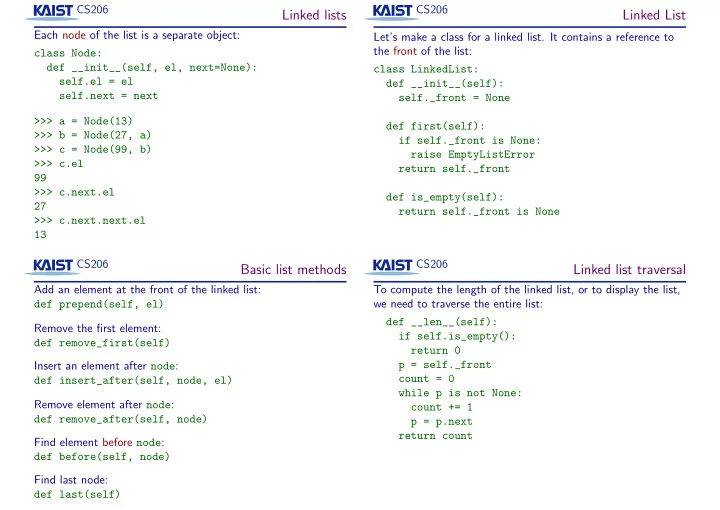

CS206 CS206 Linked lists Linked List Each node of the list is a separate object: Let’s make a class for a linked list. It contains a reference to the front of the list: class Node: def __init__(self, el, next=None): class LinkedList: self.el = el def __init__(self): self.next = next self._front = None >>> a = Node(13) def first(self): >>> b = Node(27, a) if self._front is None: >>> c = Node(99, b) raise EmptyListError >>> c.el return self._front 99 >>> c.next.el def is_empty(self): 27 return self._front is None >>> c.next.next.el 13 CS206 CS206 Basic list methods Linked list traversal Add an element at the front of the linked list: To compute the length of the linked list, or to display the list, def prepend(self, el) we need to traverse the entire list: def __len__(self): Remove the first element: if self.is_empty(): def remove_first(self) return 0 p = self._front Insert an element after node : count = 0 def insert_after(self, node, el) while p is not None: Remove element after node : count += 1 def remove_after(self, node) p = p.next return count Find element before node : def before(self, node) Find last node: def last(self)
CS206 CS206 Linked list with fast append Linked Queues Appending to the list takes time linear in the length of the list. Remember the Queue ADT? • enqueue To speed this up, the list needs to store a reference to both the • dequeue first and last node of the list: • front class LinkedList: • is_empty def __init__(self): We can implement this as a linked list with fast append: self._front = None self._rear = None • enqueue appends at the rear of the list, • dequeue removes from the front of the list. Now append is fast and easy: Now you know why the two ends of a queue are called front def append(self, el) and rear. . . But we have to be careful with all our other methods. . . The rear field must be updated by every method of the LinkedList class. CS206 CS206 Doubly-linked lists Sentinels If we want to be able to quickly search a list both forward and In doubly-linked lists, the code for inserting and removing elements needs to handle the case where the node is the first backward, we need a doubly-linked list. node and/or the last node separately. front rear We can simplify the code by using sentinel nodes. Sentinel nodes are “guarding” the two ends of the list, so that no special handling is necessary. Sentinel nodes do not contain elements. When we create an empty list, we automatically class Node: create the two sentinel nodes, which cannot be deleted. def __init__(self, el, next=None, prev=None): self.el = el self.next = next front rear self.prev = prev
CS206 CS206 The Josephus Game The Josephus Game Given n player sitting in a circle, and a number m . Given n player sitting in a circle, and a number m . A hot potato starts at player 1 , and is passed around m times. A hot potato starts at player 1 , and is passed around m times. The player holding the potato then is eliminated, the next The player holding the potato then is eliminated, the next player gets the potato, and the game continues until only one player gets the potato, and the game continues until only one player is left. player is left. n = 6 , m = 2 n = 6 , m = 2 A B A B F C E D E CS206 What data structure to use? We need a data structure to store the circle of people. Required methods: • Pass the potato to the next person. • Delete the person holding the potato. A doubly linked list does it all. A circular linked list would be even better, but we can simulate that easily.
Recommend
More recommend